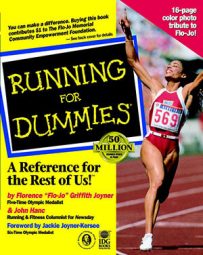Before you make the transition from walking to running, here are the answers to the most basic and commonly asked beginners' questions.
How often should I run?
The short answer is "not every day." Indeed, for all but the very best runners — those people who have built-for-the-long-haul bodies — running seven days a week, week in and week out, is a surefire recipe for injury. Instead, try to shoot for four workouts a week. But don't assume that you don't have to do anything on the other three days. In fact, the U.S. Surgeon General's office recommends that all Americans get 30 minutes of moderate activity every day. That doesn't necessarily mean running 30 minutes a day. You can walk, cycle, or perform household chores or yard work to get in your 30 minutes of activity.
How long should I run?
The American College of Sports Medicine defines aerobic exercise as activity that lasts from 20 to 60 minutes. That's a wide span. Forty-five minutes is the so-called gold standard of aerobic exercise. You can benefit from doing a little less or a little more, but many cardiologists agree that 45 minutes is the ideal length of time needed to accrue many of the physiological benefits of aerobic exercise. So although you certainly won't start out by running 45 minutes, ultimately that's a good goal to shoot for.
How hard should I run?
As you make the transition from walking to running, remember this: Running is not sprinting. You should perform your running intervals at a comfortable pace. The best way for a beginner to find the right pace is to use the time-honored talk test. If you can comfortably carry on a conversation while you're running — without huffing and puffing — you're in the right training zone. If you can carry a tune — that is, find the breath to sing — you're probably not running hard enough.
You're an exception to our guidelines if you've had heart problems in the past. In that case, your cardiologist will probably have you wear a heart monitor when you start exercising.
Where should I run?
Runners tend to run in one of four places:
- Tracks
- Roads
- Trails
- Treadmills
Beginning runners should start with the track and then eventually explore the other three options.
The local high school or college oval, which is 400 meters or about a quarter-mile long, offers a measured distance, a good surface, and a closed, safe environment. Also, if you're a bit self-conscious, you can run there and not worry about nosy neighbors getting a glimpse of you in shorts and strange-looking shoes.
So one of the steps to starting a running program is to find a local track -- emphasis on local. If it takes you two hours to drive to it, that's one more potential excuse to blow off your workout.
Another option is a marked, measured recreational path at a local park. Another possibility is to hop in your car and measure out a mile-long loop in your neighborhood, starting and ending at your door. Make sure that the route follows a road that's well paved and as traffic-free as possible. You want a place where you can concentrate and feel relatively comfortable. This is, after all, where you're going to learn to run.
The walk/run approach: A program to get you going
After you're comfortably able to regularly complete 45 minutes of brisk nonstop walking, you're ready to incorporate a little running into your routine. How little will depend on you. But here's what we recommend:
1. The day that you're ready to start running, go down to the track and walk four laps.
If you don't have access to a track, walk for 16 minutes.
2. Now try a nice easy jog for one lap, or about 2 to 3 minutes.
If one lap is too much, try a half lap.
Don't worry about speed. Just stay relaxed, maintain a "conversational" pace, and focus on good form.
3. Now walk two laps (or about 8 minutes) and jog another lap (about 2 to 3 minutes).
4. To finish up, walk four laps, or about 16 minutes.
That's three miles on a quarter-mile track. You've just finished a good 45-minute workout. Try doing that for the next couple exercise sessions. Remember that you should be working out three to four times a week, or every other day. Your body needs 48 hours to adapt to the new workload that you've placed upon it.
As you continue to train (and if you are feeling good), you can increase that ratio of jogging to walking. Try walking for two laps (or about 8 minutes) and then jogging for two laps (or about 6 minutes). Or walk a lap and jog a lap, until you've exercised for about 45 minutes or 3 miles.
It's natural to have some muscle aches when you begin a new exercise program. But any injury that hurts during the walking phase of your early training sessions should not be subjected to running. Check with a doctor who has experience treating runners if you suspect that you have a running-related injury.

